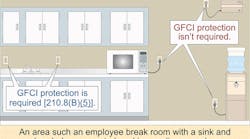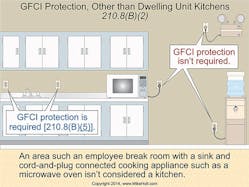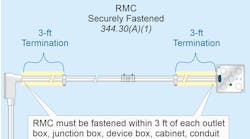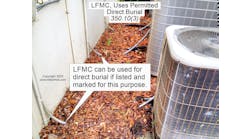Q. Where is GFCI protection required for 15A and 20A, 125V rated receptacles in locations other than dwelling units?
Find the Answer
A. GFCI protection is required for 15A and 20A, 125V receptacles installed in the following commercial/industrial locations [210.8(B)]:
1) Bathrooms. 15A and 20A, 125V receptacles installed in commercial or industrial bathrooms must be GFCI protected. See the definition of “Bathroom” in Art. 100. Note: A 15A or 20A, 125V receptacle isn’t required in a commercial or industrial bathroom, but if one is installed, it must be GFCI protected.
2) Kitchens. 15A and 20A, 125V receptacles installed in a kitchen, even those that don’t supply the countertop surface, must be GFCI protected. A kitchen is an area with a sink and permanent provisions for food preparation and cooking [Art. 100]. GFCI protection isn’t required for receptacles rated other than 15A and 20A, 125V in these locations. Also, GFCI protection isn’t required for hard-wired equipment in these locations. An area such an employee break room with a sink and cord-and-plug-connected cooking appliance such as a microwave oven isn’t considered a kitchen.
3) Rooftops. 15A and 20A, 125V receptacles installed on rooftops must be GFCI protected. Note: A 15A or 20A, 125V receptacle outlet must be installed within 25 ft of heating, air-conditioning, and refrigeration equipment [210.63]. However, there is an Exception to this rule, which states that receptacles on rooftops aren’t required to be readily accessible other than from the rooftop.
4) Outdoors. 15A and 20A, 125V receptacles installed outdoors must be GFCI protected.
Exception No. 2 to (3) and (4): GFCI protection isn’t required for a receptacle that’s supplied by a branch circuit dedicated to fixed electric snow-melting or deicing or pipeline and vessel heating equipment, if the receptacle isn’t readily accessible and the equipment or receptacle has ground-fault protection of equipment (GFPE) [426.28 and 427.22].
5) Sinks. 15A and 20A, 125V receptacles installed within 6 ft of the outside edge of a sink must be GFCI protected.
Exception No. 1: In industrial laboratories, receptacles used to supply equipment where removal of power would introduce a greater hazard aren’t required to be GFCI protected.
Exception No. 2: Receptacles located in patient bed locations of general care or critical care areas of health care facilities aren’t required to be GFCI protected.
6) Indoor wet locations. 15A and 20A, 125V receptacles installed indoors in wet locations must be GFCI protected.
7) Locker rooms. 15A and 20A, 125V receptacles installed in locker rooms with associated showering facilities must be GFCI protected.
8) Garages. 15A and 20A, 125V receptacles installed in garages, service bays, and similar areas must be GFCI protected, unless they’re in show rooms or exhibition halls.






